Cullan Hudson's Blog, page 22
July 21, 2013
Author Uncovers Bone Controversy
 "THE BONE WAR OF MCCURTAIN COUNTY by Russell Ferrell. Subtitled A true story of two ordinary men's quest for treasure and their battle against extraordinary odds (Expanded edition). 2013.
"THE BONE WAR OF MCCURTAIN COUNTY by Russell Ferrell. Subtitled A true story of two ordinary men's quest for treasure and their battle against extraordinary odds (Expanded edition). 2013.Oklahoma has many strange and hard to believe chapters in its short history as a state. Author Russell Ferrell has uncovered one of the more bizarre, and convoluted, cases ever. It all started when two guys found some bones...
In just over 400 pages, The Bone War of McCurtain County has packed a story whose complexity, importance, and historical value can only be described as 'epic.' In the story of how two intelligent and capable amateurs were finally able to prevail against corporate greed,intimidation, academic short-shortsightedness, research rivalries, and worse is an important lesson for everyone. The author so completely explains the history, processes, and meaning of events that, even a reader without any knowledge of southeast Oklahoma, dinosaurs, fossil hunting, or confusions of legal and political activity- can clearly understand the struggles chronicled.
Cephis Hall and Sid Love - co-discoverers of the rare find - have to join the ranks of 20th century folk heroes. They battled the Weyerhaeuser Corporation of McCurtain County (OK), elitist academics and false accusations and raids by armed police. They fought against corruption, ignorance, and short sighted government.
Read an interview with the author here."
Published on July 21, 2013 05:54
July 18, 2013
A Medieval Mystery In The Arizona Desert?
This is an intriguing segment of America Unearthed, an anomalous archaeology program on H2, a History channel. In this episode, Scott Wolter (the host and a forensic geologist) investigates a runestone memorial to a man named "Rough Hurech" tucked away in a remote cave in southern Arizona that just might indicate the burial of a 12 century Englishman.
While fascinating, I must confess to at least one point of contention with what is going on here: the runic inscription an unnamed consultant claims is 12th century English. My problem with this is that 12th century runic English doesn't seem likely since after 1066 the Latin alphabet was predominantly used for the English language. Even by the 10th century, the runic alphabet in English was largely relegated to manuscripts.
However, if true, this tells us that the individual who wrote it was likely a religious man or scholar of sorts.
Our host then examines the Gila cliff dwellings in neighboring New Mexico, a location that the superintendent of the monument asserts asserts can 100% be attributed to Native Americans. Why our host was directed to the site or what he hoped to find there is never explained and the whole trip is dropped as he jets to Staffordshire, England to investigate a connection across the pond. Turns out a site in England has a similar--and only a similar--look to the the Gila cliff dwellings tucked into the New Mexican sandstone cliffs.
Five minutes from these similar sandstone hovels in Staffordshire (which are said to be Tolkien's inspiration for his Hobbit houses) is the purported former home of one Peter Hurech. But the Whittington Inn is a 14th century manor home built by Sir William de Whittington, a knight. Although in this episode, our host's guide tells him (perhaps erroneously) that it dates to the 1200s (we're looking for someone from the 1100s) and was the home of Peter de Hurech. Although I can find no connection to a Hurech name and the Whittington Manor.
It is possible the manor house was built on the site of a still older home, one in which a Hurech lived. There isn't much readily-available information though and it would take some digging to confirm this story.
Is this another example of a History Channel hyperbole, of taking threadbare tidbits of disparate half-truths and quilting them into whatever story our proponents want to here? It's common motif found among these programs. I wouldn't be surprised. But then mysteries, including those surrounding pre-Columbian American runes, abound and aren't all as easy to dismiss as this.
While fascinating, I must confess to at least one point of contention with what is going on here: the runic inscription an unnamed consultant claims is 12th century English. My problem with this is that 12th century runic English doesn't seem likely since after 1066 the Latin alphabet was predominantly used for the English language. Even by the 10th century, the runic alphabet in English was largely relegated to manuscripts.
However, if true, this tells us that the individual who wrote it was likely a religious man or scholar of sorts.
Our host then examines the Gila cliff dwellings in neighboring New Mexico, a location that the superintendent of the monument asserts asserts can 100% be attributed to Native Americans. Why our host was directed to the site or what he hoped to find there is never explained and the whole trip is dropped as he jets to Staffordshire, England to investigate a connection across the pond. Turns out a site in England has a similar--and only a similar--look to the the Gila cliff dwellings tucked into the New Mexican sandstone cliffs.
Five minutes from these similar sandstone hovels in Staffordshire (which are said to be Tolkien's inspiration for his Hobbit houses) is the purported former home of one Peter Hurech. But the Whittington Inn is a 14th century manor home built by Sir William de Whittington, a knight. Although in this episode, our host's guide tells him (perhaps erroneously) that it dates to the 1200s (we're looking for someone from the 1100s) and was the home of Peter de Hurech. Although I can find no connection to a Hurech name and the Whittington Manor.
It is possible the manor house was built on the site of a still older home, one in which a Hurech lived. There isn't much readily-available information though and it would take some digging to confirm this story.
Is this another example of a History Channel hyperbole, of taking threadbare tidbits of disparate half-truths and quilting them into whatever story our proponents want to here? It's common motif found among these programs. I wouldn't be surprised. But then mysteries, including those surrounding pre-Columbian American runes, abound and aren't all as easy to dismiss as this.
Published on July 18, 2013 07:44
The Hutchison Effect: Mystery or Hoax?
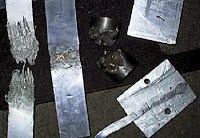 In 1979, eccentric inventor John Hutchison attempted to reproduce several of Nikola Tesla's experiments. In the course of these experiments, strange attendant phenomena were reported by Hutchison: Objects were claimed to have levitated; Other materials, though disparate in composition (such as wood and metal), fused together at a molecular level; some metals spontaneous fractured or heated to tremendous temperatures without scorching surrounding materials; other metals demonstrated marked changes in the physical properties; and smaller objects disappeared altogether. The Canadian tinkerer eponymously termed these phenomena "The Hutchison Effect."
In 1979, eccentric inventor John Hutchison attempted to reproduce several of Nikola Tesla's experiments. In the course of these experiments, strange attendant phenomena were reported by Hutchison: Objects were claimed to have levitated; Other materials, though disparate in composition (such as wood and metal), fused together at a molecular level; some metals spontaneous fractured or heated to tremendous temperatures without scorching surrounding materials; other metals demonstrated marked changes in the physical properties; and smaller objects disappeared altogether. The Canadian tinkerer eponymously termed these phenomena "The Hutchison Effect."However, Hutchison couldn't reproduce these results. Still, legend claims these experiments were so fantastic that both NASA and Military scientists were intrigued, but they too were unable to reproduce the bizarre phenomena.
In evidence, Hutchison has only his testimony and a few videos. You can find some videos online or pay Hutchison as much as $150 to send the complete set mail-order. These claim to demonstrate what had happened, but almost all of it is easily achieved with camera tricks and some clever staging. His word doesn't seem to be worth much since a television special aired one of his videos that clearly showed a string affixed to a toy UFO he claimed was "levitating".
Moreover, if he says he is unable to reproduce the effect, how is it that there are all these videos? Most of the videos are not focused on reproducing a Tesla experiment, but rather focused on demonstrating this eponymous effect. If he were videotaping his experiments and accidentally caught the other phenomena, I could understand. But most of the videos show him focusing soley on these so-called unexplained phenomena.
Supporters (those late night radio listening types) believe his experiment created a hypothetical electromagnetic wave known as a scalar wave. This allowed his mechanism to tap the much talked about unicorn known as zero-point energy, a free-for-all windfall of unlimited potential energy is we could only figure out how to harness it.
Published on July 18, 2013 05:16
July 17, 2013
It's Raining Blobs, Hallelujah!
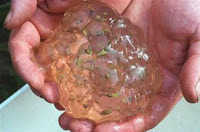 If this picture, which I have found often associated
If this picture, which I have found often associated with the story, is to be believed, I must note how
many various individuals have commented on the
remarkable similarity to a gelatinous cluster
of amphibian eggs. On August 7, 1994, the people of Oakville, WA experienced a frightening event when a deluge of gelatinous blobs fell from the sky. In time, those exposed became sick with flu-like symptoms. Washington State's Department of Ecology examined the globules, noting they seemed to be made of a number of different animal cells but couldn't pin-point their origin.
Dr. David Little, an Oakville physician, had the substance tested as well and stated it contained human cells that remarkably possessed no nuclei. Moreover, the substance contained two types of bacteria, one of which is also found in the human digestive tract.
Some theorized that military bombing tests some fifty miles out to sea could have flung jellyfish filled sea water into the clouds where it somehow managed to stay suspended long enough to travel inland and rain down on the locals. And contain human cells. And I'm not buying that one either.
Even if you discount the human cells stuff, the prospect of those blobs staying suspended for any length of time without the presence of violent updrafts (as accompanied with thunderstorms) is a hard one to swallow.
So we chalk this up to another one of the weird Fortean falls that goes unexplained but not forgotten.
Published on July 17, 2013 06:32
July 12, 2013
Near Miss Over London (1933)
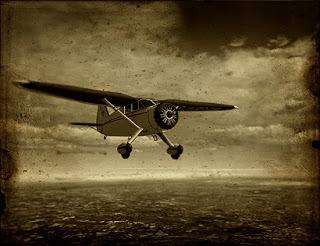
In late November 1933, two pilots encountered a strange object around a 1,000 up in the skies over the London borough of Harrow. The pilots, Mrs. Alan Butler (a famous racing pilot of the time) and Mr. Guy Robson reported upon landing in Heston of their strange encounter with 'a contraption of unorthodox design' that was roughly the size of a small plane. Reports vary wildly, calling it everything from a sky monster to describing it as a box kite with the pilots narrowly missing the cables that moored it to ground hundreds of feet below.
Did the pilots encountered some type of weather instrument tied to the ground and sailing dangerously above? With the size described, it would be an exceptionally large box kite. Most that carried instruments at the time weren't much larger than a wardrobe. And how could two separate pilots--one of whom was an experienced racer--have missed that there would be a kite unfurled to 1,000 feet in their flight path?
And what of the description of it being a 'monster'? Is that journalistic hyperbole designed to sell? The pilots themselves described it as a 'contraption', so they knew it was a machine and not a monster.
Was this an early report of a UFO? Or could it have been a dangerous case of mistaken identity by two experience pilots?
Published on July 12, 2013 06:38
July 11, 2013
Thrift Store Treasure
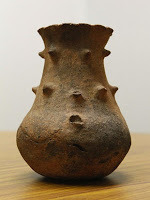 I found this image on Pinterest. The individual who posted it reported that it is a 1,000 year-old "Indian artifact" taken from a Native American burial site in Oklahoma. I wonder if it is true. No further details are provided so I can't say who discovered the item or how it was authenticated. Does this sort of thing happen a lot? There's an idea for a TV show: Lost Treasures of Thrift Stores.
I found this image on Pinterest. The individual who posted it reported that it is a 1,000 year-old "Indian artifact" taken from a Native American burial site in Oklahoma. I wonder if it is true. No further details are provided so I can't say who discovered the item or how it was authenticated. Does this sort of thing happen a lot? There's an idea for a TV show: Lost Treasures of Thrift Stores.
Published on July 11, 2013 05:11
July 9, 2013
A Paranormal Pop Culture Primer
 Currently reading The Paranormal Pop Culture Collection, a collection of essays on the paranormal in pop culture (hence the title) and interviews with paracelebs, actors, and personalities. I met the author, Aaron Sagers, this past weekend at the Roswell UFO Festival. He had a table set up in the Museum to support his site www.paranormalpopculture.com . Sagers is a journalist that has covered these topics for such varied outlets as Travel Channel, CNN, MTV, and BBC. The book includes interview with members of Destination Truth, Ghost Hunters, and many more. It's definitely worth the read. Sager delivers a deeper look at the personalities behind the screen personas and dissects disparate topics such as Werewolves vs. Vampires and Zombie Preparedness.
Currently reading The Paranormal Pop Culture Collection, a collection of essays on the paranormal in pop culture (hence the title) and interviews with paracelebs, actors, and personalities. I met the author, Aaron Sagers, this past weekend at the Roswell UFO Festival. He had a table set up in the Museum to support his site www.paranormalpopculture.com . Sagers is a journalist that has covered these topics for such varied outlets as Travel Channel, CNN, MTV, and BBC. The book includes interview with members of Destination Truth, Ghost Hunters, and many more. It's definitely worth the read. Sager delivers a deeper look at the personalities behind the screen personas and dissects disparate topics such as Werewolves vs. Vampires and Zombie Preparedness.
Published on July 09, 2013 07:17
July 8, 2013
MY ROSWELL SLIDE SHOW (Someone get the lights!)
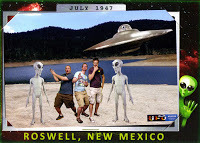 Road Trip!!This past holiday weekend, I met up with old friends and we journeyed to the UFO capital of Roswell, New Mexico for its annual UFO festival, which celebrates the alleged crash of a flying saucer in 1947. The festival is equal parts UFO conference, street fair, and calorie fest. C'mon, how could one even think of passing up both stuffed sopapillas AND the requisite funnel cakes?
Road Trip!!This past holiday weekend, I met up with old friends and we journeyed to the UFO capital of Roswell, New Mexico for its annual UFO festival, which celebrates the alleged crash of a flying saucer in 1947. The festival is equal parts UFO conference, street fair, and calorie fest. C'mon, how could one even think of passing up both stuffed sopapillas AND the requisite funnel cakes? 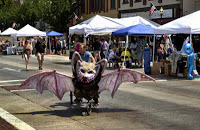 The festival is a melange of characters that stands in stark relief against the small town demographics of southeastern New Mexico. Head-scratching farmers and ironic hipsters rub elbows with wide-eyed kids and die-hard enthusiasts clad stiflingly in metallic fabrics and purple wigs.
The festival is a melange of characters that stands in stark relief against the small town demographics of southeastern New Mexico. Head-scratching farmers and ironic hipsters rub elbows with wide-eyed kids and die-hard enthusiasts clad stiflingly in metallic fabrics and purple wigs. The beating heart of the festival was undoubtedly the famous UFO Museum, a kitschy conglomeration of artifacts cobbled from years of effort on the part of tireless researchers and enthusiasts. It's a historical walk through the events surrounding the now-famous crash as well as a chronicle of other important UFO events. Scattered among these are seemingly countless UFO models, life sized animatronic aliens, and posters celebrating Roswell's impact on pop culture.
The beating heart of the festival was undoubtedly the famous UFO Museum, a kitschy conglomeration of artifacts cobbled from years of effort on the part of tireless researchers and enthusiasts. It's a historical walk through the events surrounding the now-famous crash as well as a chronicle of other important UFO events. Scattered among these are seemingly countless UFO models, life sized animatronic aliens, and posters celebrating Roswell's impact on pop culture.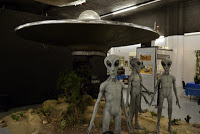
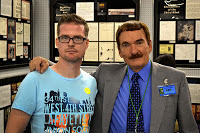 It was here at the museum that visitors were able to meet up close and personal such legendary figures as Travis Walton, a man famous for his well-documented abduction from a Arizona mountain top in the 1970s. The story went on to be made into the film,
Fire in the Sky
, which starred D. B. Sweeney and Robert Patrick. Knowing that many of the loggers involved in the incident were early on quite reticent about embracing the event (himself most of all), I asked Mr. Walton if he thought that his experience was something of a double-edged sword, a necessary evil. With a heavy sense of resignation, he admitted as much. While the tale has brought him a degree of respect and has given his life a new trajectory, it requires him to continue carrying the weight of his experience--and all its implications. Later, we listened as Walton relayed his experience in a talk to a room overflowing with attendees.
It was here at the museum that visitors were able to meet up close and personal such legendary figures as Travis Walton, a man famous for his well-documented abduction from a Arizona mountain top in the 1970s. The story went on to be made into the film,
Fire in the Sky
, which starred D. B. Sweeney and Robert Patrick. Knowing that many of the loggers involved in the incident were early on quite reticent about embracing the event (himself most of all), I asked Mr. Walton if he thought that his experience was something of a double-edged sword, a necessary evil. With a heavy sense of resignation, he admitted as much. While the tale has brought him a degree of respect and has given his life a new trajectory, it requires him to continue carrying the weight of his experience--and all its implications. Later, we listened as Walton relayed his experience in a talk to a room overflowing with attendees.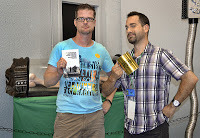 I also was fortunate to chat at length with Aaron Sagers, a journalist and TV personality that has worked with the likes of Travel Channel, CNN, and MTV to report on the paranormal in pop culture. Sagers authored the book The Paranormal Pop Culture Collection. You can learn more about Sagers and his work at www.paranormalpopculture.com To explain the pic better, he was quite fascinated by the metal mug I picked up at a root beer stand outside. I'm holding a copy of his book, which I look forward to reading soon.
I also was fortunate to chat at length with Aaron Sagers, a journalist and TV personality that has worked with the likes of Travel Channel, CNN, and MTV to report on the paranormal in pop culture. Sagers authored the book The Paranormal Pop Culture Collection. You can learn more about Sagers and his work at www.paranormalpopculture.com To explain the pic better, he was quite fascinated by the metal mug I picked up at a root beer stand outside. I'm holding a copy of his book, which I look forward to reading soon.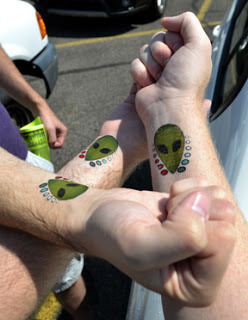
For three days, the events were piled on: lectures by the likes of Stanton Friedman, costume contests (including one for pets), live entertainment, carnival rides, a parade... And did I mention the junk food. Seriously, if you've never made the trek to Roswell, you should. Makes for an awesome road trip--especially during the UFO Festival.
See more from my trip HERE.
Published on July 08, 2013 06:15
Google Goes Ga Ga Over Roswell
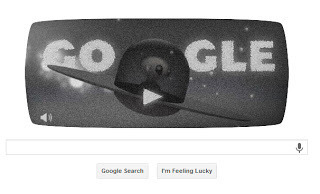 Go to the Google homepage to view Google's little flying saucer interactive video. The little man from Mars crashes to earth and then the fun begins as you navigate him through his new home.
Go to the Google homepage to view Google's little flying saucer interactive video. The little man from Mars crashes to earth and then the fun begins as you navigate him through his new home.
Published on July 08, 2013 04:27
June 26, 2013
THE ICEMAN COMETH (again)
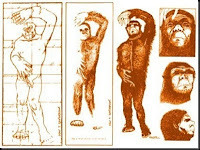 FOR IMMEDIATE RELEASE: The Long Lost “Minnesota Iceman” Resurfaces… in Austin, Texas!
FOR IMMEDIATE RELEASE: The Long Lost “Minnesota Iceman” Resurfaces… in Austin, Texas!In 1968 a carnival attraction being billed as “The Siberskoye Creature” began showing up at malls and fairgrounds across America. Also known as “The Creature In Ice,” the exhibit appeared to be the body of a hairy Neanderthal or Bigfoot-like monster frozen in a solid block of ice in a refrigerated coffin.
The “Iceman” soon garnered the attention of scientists, the Smithsonian Institution, and even the FBI, who all wanted to get their hands on the creature. Then, as suddenly as it appeared, the Iceman seemed to mysteriously vanish without a trace, and along with it all hopes of ever having the body thoroughly examined.
Over the ensuing decades the enigma of the Minnesota Iceman, as it were later to be called, became the subject of many books, lectures and television shows including Unsolved Mysteries and Animal X. The story grew to near legendary status among the generation that remembered seeing it, and for over three decades the mystery of whatever happened to it became as much an open question as whatever “IT” actually was.
Now, after many years of its whereabouts being unknown, the long enduring mystery of “Where is the Minnesota Iceman?” can finally be answered.
Museum of the Weird owner Steve Busti announced today that the original Minnesota Iceman is currently in his possession, still frozen, and will soon be exhibited to the world once again in his Austin, Texas tourist attraction. Busti is aiming to have the Iceman set up in his museum and open to the public within a week, with plans for a special Grand Opening event on Saturday, July 13th in cooperation with eminent cryptozoology site Cryptomundo.com.
The Museum of the Weird is an homage to dime museums made popular by the likes of P.T. Barnum, and features everything from real mummies, shrunken heads and oddities, to wax figures of classic movie monsters, to live giant lizards. They even boast a live sideshow on stage every day, where one can see magicians, sword-swallowers, human blockheads, and even an “elecrticity-proof” man.
In addition to the Minnesota Iceman taking up permanent residence at the Museum of the Weird however, Busti also plans to loan the Iceman for display to Loren Coleman’s International Cryptozoology Museum in Portland, Maine (cryptozoologymuseum.com) for a special limited future engagement. You can follow Coleman’s blog at cryptozoonews.com for forthcoming information.
Further details will be announced at a later date. In the meantime, you can find more information at museumoftheweird.com.
Published on June 26, 2013 06:50



